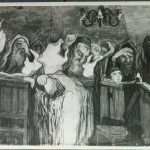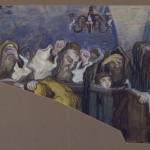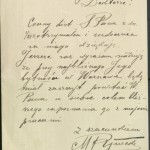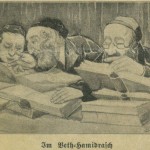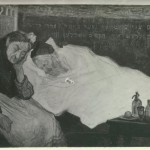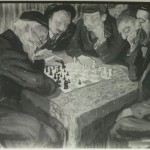In the spring of last year I was asked to give a talk at congregation Bet Haverim in Davis, California. I didn’t have a talk prepared, but my academic background is in rhetoric, and I taught public speaking in graduate school, so I didn’t think it would be too difficult to put something together, and I accepted the offer. The audience of about a hundred was really supportive and enthusiastic. I loved the experience of speaking in front of a crowd. Often on this journey I feel all alone, so it was really energizing to share my story with a caring crowd. The chance to tell more people about the paintings along with the warm reaction made me think additional talks would be worthwhile. So when planning our subsequent family vacation to Boston, I got in touch with Boston3G, a group of grandchildren of Holocaust survivors, and asked if I could give my talk to their group. They said they’d be happy to have me. The crowd in Boston was smaller than the one in Davis, but they were also hugely supportive. Given that I had told them I was headed to Toronto in the fall to film an interview with a man who had four Moshe Rynecki paintings in his home, a number of audience members suggested I give my talk at the University of Toronto.
Thinking it was a longshot, I reached out to the University of Toronto’s Center for Jewish Studies and explained my talk and my reason for travelling to Toronto. They must have thought I was half crazy for asking for an opportunity to speak. I’m an ex-academic with only a Master’s degree, I don’t have a finished book, and my film is incomplete. But my story apparently touched a chord with Professor Adam Cohen and he generously said “sure” and booked a date.
I flew to Toronto a couple of weeks ago on Canadian Thanksgiving, and that night I posted on Facebook about being reflective about the meaning and importance of my trip to Toronto. I wrote, in part, “When the Nazis invaded Poland, my great-grandfather bundled up and hid his paintings in and around the city of the Warsaw in an effort to protect his collection. He perished in Majdanek and when the surviving family tried to recover the collection, they found only the works in the basement of a single building. They thought everything else was destroyed. Sixty eight years later, I’m in a hotel room just about 45 minutes away from four other paintings that survived the war. Tomorrow I will hear the story of how the parents of this man in Toronto bought/saved/rescued a bundle of Moshe’s paintings after the war. I actually teared up today just thinking about it. What would Moshe think of this meeting? Of his works having traveled on all these different paths? I must admit that in some ways it just makes me shake my head in disbelief. It’s really all so surreal. I wish my grandpa George (Moshe’s son) was here. It would have meant the world to him to know that other works survived. Tomorrow is a big day and I am nervous, excited, jittery, and emotional.”
The interview went well, and the following day while I roamed Toronto’s streets and museums, I couldn’t really process the experience. I had thought for months about what questions to ask, how to word them, and what to emphasize. And now I had answers to those questions. It was a powerful experience that I’ve still not completely digested. The memory that held me most captive was actually touching the frames that held my great-grandfather’s pieces and peering at the cracks and creases in the art. I know the rips and tears in the pieces we own so well, but these pieces, from paint bumps to wrinkles were all new to me. It was a little like trying to read a person’s history from the lines on their face.
Two days later I gave my talk at the University of Toronto’s Center for Jewish Studies. It went well, I think, but the audience was harder to read than the Davis and Boston crowds. There was time afterwards for a few questions and there were several interesting ones about my choice to be an historian rather than a claimant. Dr. Cohen stood up and said we were running out of time, but that there was time for one more question. A man at the back raised his hand and asked “Are you aware the that University of Toronto’s Thomas Fisher Rare Book Library has the papers of Otto Schneid and in its archives are photographs of several of your great-grandfather’s paintings as well as original handwritten letters he wrote?”
It’s hard to describe how I felt in that moment. The world seemed to slow to a crawl and then stop. First of all, I hadn’t a clue what he was talking about. Second, I wanted to know if I could go RIGHT NOW to see whatever it was that was in those archives. I think that what I said when I could begin to string words together was “don’t go anywhere.”
The library happened to be open late that night and the man in the audience who raised his hand, Dr. Barry Walfish, the Judaica specialist at the University of Toronto libraries, escorted me to the library so I could see the archives. The items I saw are easy to describe. First, there were black and white photographs of many of my great-grandfather’s paintings, some of which I’d never seen before. There were handwritten letters in Polish with his distinctive signature at the bottom of each page. There were envelopes that had been used to mail the letters and they had the return address of the art supply store at 24 Krucza Street that my great-grandparents ran in Warsaw. There was a handwritten note in Yiddish that seemed to be an autobiography (the page is still being translated as I write this blog post). There was a German newspaper article about a show and the piece featured my great-grandfather and one other artist in the “winter salon” exhibit.
So describing what I saw is easy, but understanding what it means, how it all fits together, and adding context has occupied nearly all of my thinking since I was in the library. For example, I found out later that Otto Schneid had been a Czech, born to Polish parents, who in the 1930s, was writing a dictionary about Jewish artists. Somehow he learned about my great-grandfather, there was an exchange of letters, and ultimately my great-grandfather had sent him photographs of several of the pieces in his studio. Sometime after Kristallnacht, Schneid managed to flee Europe and go to Israel, where he lived for a number of years. He subsequently moved to the United States where he produced his own art, and he ended up in Toronto, where he died in 1974. His widow donated his papers to the University of Toronto’s Thomas Fisher Rare Book Library in 2002.
Those are some of the facts I learned, and it’s like finding a key piece in this giant jigsaw puzzle I’ve been trying to put together. As I said, I’m still processing the whole trove of information, but the serendipitous chain of events here is as amazing as the find itself. If I hadn’t given the talk in Davis, I wouldn’t have given it in Boston, and I would not have felt brave enough to pitch it to the University of Toronto’s Center for Jewish Studies. Just as importantly, Dr. Walfish happened to see my talk in the calendar, and decided to look up Moshe’s name in the archive. Without any of these links, I would have missed out on an important piece of my great grandfather’s past. It was, as one Twitter friend remarked, like I’d found a needle in the haystack.
Black+White photos below Courtesy of the Thomas Fisher Rare Book Library, University of Toronto.
